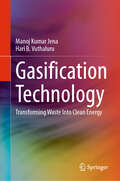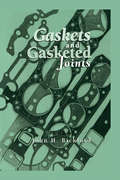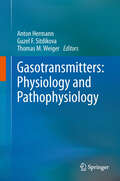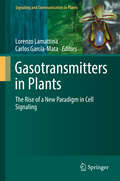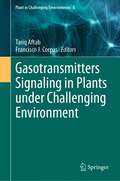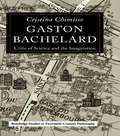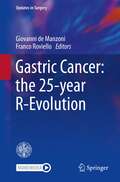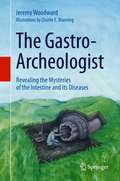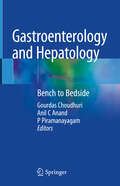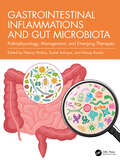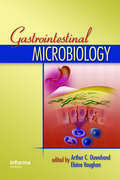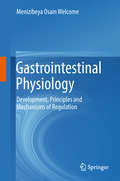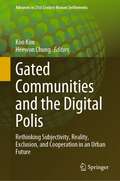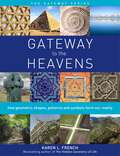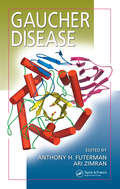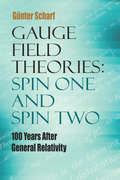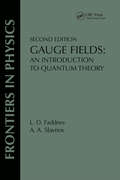- Table View
- List View
Gasification Technology: Transforming Waste Into Clean Energy
by Manoj Kumar Jena Hari B. VuthaluruThis book examines the growing interest in gasification technology, which has become the primary route for effectively utilizing solid carbonaceous material for energy generation and syngas production. The thermochemical conversion of solids, including pyrolysis, combustion, and gasification, has become a primary method for extracting energy and value-added chemicals. However, gasification technology is the most efficient and economical way to utilize solid fuel. Understanding the gasification process and its diversified applications is essential for making gasification technology sustainable in the future. This book provides readers with an in-depth understanding of gasification technology, covering its past use, present scenario, and future outlook. Specifically, in an emerging world with the rapid advancement of science and technology, this book offers knowledge on the fundamentals, applications, and sustainable advancement of gasification technology covering a wide range of solid fuels. Gasification Technology: Transforming Waste Into Clean Energy provides early career researchers, engineers, and research and development scientists with a solid knowledge base on the fundamentals, industrial applications, and commercialization of gasification. The first book to cover all aspects of gasification technology; Examines the role and importance of gasification technology and the rise in global energy demand; Integrates insights into engineering applications and the advancement of gasification as a sustainable technology.
Gaskets and Gasketed Joints (Mechanical Engineering)
by John BickfordBringing together decades of research findings into a single, coherent source, this practical guide discusses industrial, automotive, and chemical gasket types and materials from selection, installation, and testing to applications and problem-solving and prevention methods. The coverage includes, but is not limited to, the complex mechanical and l
Gasotransmitters: Physiology and Pathophysiology
by Guzel F. Sitdikova Thomas M. Weiger Anton HermannSince the epochal discovery of the radical and highly toxic gas nitric oxide (NO) as a signaling molecule, two other no less toxic gases - carbon monoxide (CO) and hydrogen sulfide (H2S) - have been found to also be involved in a plethora of physiological and pathophysiological functions. The gases termed gasotransmitters play an increasingly important role in understanding how signalling into and between cells is modulated and fine-tuned. The advent of gasotransmitters has profoundly changed our way of thinking about biosynthesis, liberation, storage and action mechanisms in cellular signaling. In recent years an impressive amount of new data, distributed throughout the existing literature, has been generated. For this book the editors have recruited distinguished colleagues in the field to summarize and review important biological, pharmacological and medical functions and their implications, as well as methods for the detection of gasotransmitters.
Gasotransmitters in Plants
by Lorenzo Lamattina Carlos García-MataThis book describes the three gasotransmitters nitric oxide (NO), hydrogen sulphide (H2S) and carbon monoxide (CO) and their function as intracellular signalling molecules in plants. Common properties are shared by NO, H2S and CO: they are beneficial at low concentrations but hazardous in higher amounts; they are small molecules of gas; they can freely cross cell membranes; their effects do not rely on receptors; they are generated enzymatically and their production is regulated; their functions can be mimicked by exogenous application; and their cellular effects may or may not be mediated by second messengers, but have specific cellular and molecular targets. In plants, many aspects of the biology of gasotransmitters remain completely unknown and generate intriguing questions, which will be discussed in this book.
Gasotransmitters in Plants: The Rise of a New Paradigm in Cell Signaling (Signaling and Communication in Plants)
by Lorenzo Lamattina Carlos García-MataThis book describes the three gasotransmitters nitric oxide (NO), hydrogen sulphide (H2S) and carbon monoxide (CO) and their function as intracellular signalling molecules in plants. Common properties are shared by NO, H2S and CO: they are beneficial at low concentrations but hazardous in higher amounts; they are small molecules of gas; they can freely cross cell membranes; their effects do not rely on receptors; they are generated enzymatically and their production is regulated; their functions can be mimicked by exogenous application; and their cellular effects may or may not be mediated by second messengers, but have specific cellular and molecular targets.In plants, many aspects of the biology of gasotransmitters remain completely unknown and generate intriguing questions, which will be discussed in this book.
Gasotransmitters Signaling in Plant Abiotic Stress: Gasotransmitters in Adaptation of Plants to Abiotic Stress (Signaling and Communication in Plants)
by Mehar Fatma Zebus Sehar Nafees A. KhanThis book deals with the gasotransmitters signaling in redox reactions and homeostasis for the adaptation of plants to unfavorable abiotic stress environments. There are lots of interesting chapters in this book that cover both research and educational objectives. This book serves as a reference illustrated book for all who are interested in the regulation of gasotransmitters and redox homeostasis in agriculture. Maintenance of redox homeostasis strengthens the potentiality of plants to resist abiotic stress conditions through the enhanced antioxidant system and the subsequent impact on other signaling molecules. The book presents novel outcomes and implications in plant biology concerning the study of different types of gasotransmitters signaling such as nitric oxide (NO), ethylene, hydrogen sulfide (H2S), etc. under diverse abiotic stresses in one place. The chapters of the book discuss the recent progress and current perspectives on the role of gasotransmitters relevance to plant functions and adaptations to abiotic stresses, the influence of gasotransmitters on the physiology of plants with respect to abiotic stress tolerance, gasotransmitters and omics for abiotic stress tolerance, advancement in the biology of gasotransmitters in regulating salinity and drought stress response in plants, new insights of gasotransmitters and cellular redox homeostasis in plants and the chapter also deliberate the emerging role of gasotransmitters in regulating redox homeostasis for plant stress management. This book is the first comprehensive book covering all aspects and advancements in the biology of gasotransmitters in redox homeostasis conferring different abiotic stress tolerance, from which readers from all backgrounds can get benefitted. This book will appeal to researchers, students, scientific societies, agriculturists, etc.
Gasotransmitters Signaling in Plants under Challenging Environment (Plant in Challenging Environments #5)
by Tariq Aftab Francisco J. CorpasAbiotic stressors, such as drought, extreme temperatures, heavy metals, or high salinity, are causing huge crop losses worldwide. These abiotic stressors are expected to become more extreme, less predictable, and more widespread in the near future. The harm of abiotic stresses includes the disruption of cellular redox homeostasis, reactive oxygen species (ROS) production, and oxidative stress in the plant. Plants have different mechanisms to fight stress, and these mechanisms are responsible for maintaining the required homeostasis in plants. Research on gasotransmitters is rapidly expanding and knowledge regarding the potential of gasotransmitters in biology and medicine is accumulating. Over the past few decades, the roles of these signaling molecules, especially NO and H2S, have been extensively studied for their application in plants. Recently, the emissions of endogenous gasotransmitters in plants have been widely studied and analyzed, thereby providing information to facilitate our understanding of new gasotransmitters signaling pathways. Given the multidimensional role of these signaling molecules, research over the past decades in mitigating abiotic stresses in plant biology and from an agriculture point of view, we intend to bring forth a comprehensive volume “Gasotransmitters Signaling in Plants under Challenging Environment". We are hopeful that this comprehensive volume will furnish the requisite of all those who are working or have an interest in the proposed topic
Gaston Bachelard: Critic of Science and the Imagination (Routledge Studies in Twentieth-Century Philosophy #Vol. 9)
by Cristina ChimissoIn this new study, Cristina Chimisso explores the work of the French Philosopher of Science, Gaston Bachelard (1884-1962) by situating it within French cultural life of the first half of the century. The book is introduced by a study - based on an analysis of portraits and literary representations - of how Bachelard's admirers transformed him into the mythical image of the Philosopher, the Patriarch and the 'Teacher of Happiness'. Such a projected image is contrasted with Bachelard's own conception of philosophy and his personal pedagogical and moral ideas.This pedagogical orientation is a major feature of Bachelard's texts, and one which deepens our understanding of the main philosophical arguments. The primary thesis of the book is based on the examination of the French educational system of the time and of French philosophy taught in schools and conceived by contemporary philosophers. This approach also helps to explain Bachelard's reception of psychoanalysis and his mastery of modern literature. Gaston Bachelard: Critic of Science and the Imagination thus allows for a new reading of Bachelard's body of work, whilst at the same time providing an insight into twentieth century French culture.
Gastric Cancer: the 25-year R-Evolution (Updates in Surgery)
by Franco Roviello Giovanni De ManzoniTwenty-five years ago, a monograph on gastric cancer was published by the Italian Society of Surgery: that book is recognized as a milestone in the management of these tumors in Italy. Oncological and surgical knowledge in the field of gastric cancer have changed dramatically over the last 25 years. The aim of this book is to offer an essential update on current diagnostic approaches and optimal treatment strategies. It gives comprehensive information on gastric cancer not neglecting the basic sciences, which can shed light on the carcinogenesis mechanisms involved in this pathology. The principles of tailored and multimodal treatment are examined according to the latest guidelines with the aim of providing a valuable synopsis for clinicians. The book not only reviews what has changed in the field of gastric cancer over the past quarter century but also offers the reader a glimpse of the future by describing the ongoing surgical and oncological trials which focus on new treatment frontiers such as immunotherapy and target therapy. It also seeks to incorporate the latest discoveries based on molecular classifications. Further, the book reflects the findings and experiences of Italian experts belonging to the GIRCG (Italian Research Group for Gastric Cancer) and will offer an excellent guide for oncological surgeons in their daily practice of caring for patients affected by gastric cancer.
The Gastro-Archeologist: Revealing the Mysteries of the Intestine and its Diseases
by Jeremy WoodwardIn order to understand common conditions such as coeliac disease and Crohn’s disease, one must view the gut in its evolutionary context. This is the novel approach to the gut and its diseases that is adopted in this book. The first part tells the story of the evolution of the gut itself – why it came about and how it has influenced the evolution of animals ever since. The second part focuses on the evolution of immunity and how the layers of immune mechanisms are retained in the gut, resembling the strata revealed in an archeological dig. The final part, ‘The Gastro-Archeologist’, ties the first two together and highlights how understanding the gut and immune system in their evolutionary context can help us understand diseases affecting them.Ambitious in its scope but telling a unique story from a refreshingly novel perspective, the book offers an informative and enjoyable read. As the story of the gut, immunity and disease unfolds, the author aims to endow readers with the same sense of awe and excitement that the subject evokes in him. Difficult concepts are illustrated using simple and colourful analogies, and the main content is supplemented with anecdotes and unusual and amusing facts throughout the book. The book is intended for anyone with an interest in the gut, its immunity and diseases, ranging from school and college biology and biomedical students, to professionals working in the field, and to patients suffering from intestinal diseases who want to understand more about their conditions.
Gastroenterology and Hepatology: Bench to Bedside
by Gourdas Choudhuri Anil C Anand P PiramanayagamThe book aims to be a handy compendium to the very voluminous texts of gastroenterology and hepatology existing in the knowledge market and provides the reader with an easy understanding of the bench knowledge (basic sciences) as they apply to bedside practice (clinical gastroenterology). With introduction and contributions from Prof Eamon Quigley, Former president of World Gastroenterology Organization and American College of Gastroenterology, the book covers the recent advances in the basic sciences that form an important pillar of the knowledge, thereby linking basic sciences such as anatomy, physiology, biochemistry, molecular medicine, etc. to clinical conditions, diseases and new therapeutic approaches in gastroenterology and hepatology. The book is written in a simple easy to read format, with a lot of diagrams and flowcharts, making it a handy guide. It also discusses in-depth about very common clinical conditions encountered in hospital settings such as ulcerative colitis, pseudomembranous colitis, colonic cancer, amebiasis, and various other syndromes and diseases. This book is a useful read for fellows and trainees in Gastroenterology and Hepatology, as well as gastroenterologists, hepatologists and physicians interested in digestive disorders.
Gastrointestinal Inflammations and Gut Microbiota: Pathophysiology, Management, and Emerging Therapies
by Anoop Kumar Neeraj Mishra Sumel AshiqueThis book offers a comprehensive and multi-faceted examination of gastrointestinal inflammations, discussing factors that impact gut health. The initial chapters establish a foundational understanding of gastrointestinal inflammations and the critical role of the gut microbiota. The book then delves into the complex pathophysiology and various risk factors associated with these conditions, offering insights into the latest diagnostic, screening, and prevention techniques. It explores the dynamic interactions between the gut and the brain as well as the biochemical interplays involving short-chain fatty acids, reactive oxygen species, and superoxide dismutases. Additionally, the book thoroughly discusses the impact of genetics on gastrointestinal health, the interactions between antibiotics and gut microbiota, and the pivotal role of the immune system in inflammation. It highlights advancements in diagnostic technologies and gut microbiota-based strategies, along with the use of nanoparticles in treatment. The book also examines the psychological aspects associated with gastrointestinal inflammations, emphasizing the importance of mental health for physical well-being. It assesses the potential of functional foods, various types of nanocarriers, and plant-based bioactives in managing gastrointestinal inflammations. As such, this book is primarily intended for researchers and students in the fields of gastroenterology and microbiology.Key Features: Provides an extensive overview of gastrointestinal inflammations, starting from the basic concepts of the gut microbiota to complex pathophysiological aspects Delves into the latest advancements in diagnostic, screening, and prevention techniques, highlighting cutting-edge technologies and approaches in gastroenterology Explores the role of the immune system and the impact of genetics and diet on gastrointestinal health Examines use of probiotics, prebiotics, postbiotics, and various nanotechnology-based approaches for gastrointestinal inflammation management Emphasis on the psychological factors associated with gastrointestinal inflammations
Gastrointestinal Microbiology
by Arthur C. OuwehandThis reference supplies a comprehensive and current overview of every aspect of gastrointestinal microbiota. Expertly written chapters cover conventional and molecular techniques for the study of differing microbial populations, as well as the analysis of microbial activity and interaction with host bodies. Illustrative and up-to-date, this source
Gastrointestinal Physiology: Development, Principles and Mechanisms of Regulation
by Menizibeya Osain WelcomeThis book offers one of the most comprehensive reviews in the field of gastrointestinal (GI) physiology, guiding readers on a journey through the complete digestive tract, while also highlighting related organs and glandular systems. It is not solely limited to organ system physiology, and related disciplines like anatomy and histology, but also examines the molecular and cellular processes that keep the digestive system running. As such, the book provides extensive information on the molecular, cellular, tissue, organ, and system levels of functions in the GI system. Chapters on the roles of the gut as an endocrine, exocrine and neural organ, as well as its microbiome functions, broaden readers’ understanding of the multi-organ networks in the human body. To help illustrate the interconnections between the physiological concepts, principles and clinical presentations, it outlines clinical examples such as pathologies that link basic science with clinical practice in special “clinical correlates” sections. Covering both traditional and contemporary topics, it is a valuable resource for biomedical students, as well as healthcare and scientific professionals.
Gastroösophageale Refluxerkrankung: Differentialdiagnostik und Therapie
by Ahmed Madisch Joachim LabenzIn diesem Praxisbuch haben Experten auf diesem Gebiet das aktuelle Wissen zur Differenzialdiagnostik und zur Therapie - konservativ bis operativ - zusammengefasst.Das klinische Bild der Refluxkrankheit ist sehr vielfältig. Neben den klassischen Symptomen Sodbrennen und Schmerz hinter dem Brustbein können auch atypische Beschwerden wie Asthma, chronischerer Husten und Heiserkeit als Folge der Refluxerkrankung auftreten. Im schlimmsten Fall kann sich auch als Folge eines langjährigen Refluxes Speiseröhrenkrebs bilden. Insbesondere bei atypischen Symptomen ist aber die Diagnostik erschwert. Hier muss die klinische Expertise durch differenzierten Einsatz von apparativer Diagnostik ergänzt werden. Dieses Praxisbuch leistet eine Hilfestellung in der Funktionsdiagnostik und erläutert mögliche Diagnoseverfahren. Im Therapieteil werden konservative wie auch operative Optionen mit notwendigen Indikationen aufgezeigt. Kapitel zu den Besonderheiten bei Kindern mit Reflux und einem Auftreten bestimmter Symptome während der Schwangerschaft runden das Buch ab. Die Inhalte orientieren sich an der aktualisierten Leitlinie „Gastroösophageale Refluxkrankheit“.Neben der hohen Prävalenz und der deutlichen Einschränkung der Lebensqualität liegt die Bedeutung der Erkrankung im breiten klinischen Spektrum an Symptomen, Komplikationen und Folgeerkrankungen mit Relevanz für zahlreiche Fachdisziplinen auch außerhalb der Gastroenterologie. So bietet dieses Buch einen kompakten Wissenstranfer zum Krankheitsbild - nicht nur für Gastroenterologen.
Gated Communities and the Digital Polis: Rethinking Subjectivity, Reality, Exclusion, and Cooperation in an Urban Future (Advances in 21st Century Human Settlements)
by Kon Kim Heewon ChungThis edited collection provides an alternative discourse on cities evolving with physically and virtually networked communities—the ‘digital polis’—and offers a variety of perspectives from the humanities, media studies, geography, architecture, and urban studies. As an emergent concept that encompasses research and practice, the digital polis is oriented toward a counter-mapping of the digital cityscape beyond policing and gatekeeping in physical and virtual gated communities. Considering the digital polis as offering potential for active support of socially just and politically inclusive urban circumstances in ways that mirror the Greek polis, our attention is drawn towards the interweaving of the development of digital technology, urban space, and social dynamics. The four parts of this book address the formation of technosocial subjectivity, real-and-virtual combined urbanity, the spatial dimensions of digital exclusion and inclusion, and the prospect of emancipatory and empowering digital citizens. Individual chapters cover varied topics on digital feminism, data activism, networked individualism, digital commons, real-virtual communalism, the post-family imagination, digital fortress cities, rights to the smart city, online foodscapes, and open-source urbanism across the globe. Contributors explore the following questions: what developments can be found over recent decades in both physical and virtual communities such as cyberspace, and what will our urban future be like? What is the ‘digital polis’ and what kinds of new subjectivity does it produce? How does digital technology, as well as its virtuality, reshape the city and our spatial awareness of it? What kinds of exclusion and cooperation are at work in communities and spaces in the digital age? Each chapter responds to these questions in its own way, navigating readers through routes toward the digital polis.Chapter "Introduction - The digital polis and its practices: Beyond gated communities" is available open access under a Creative Commons Attribution 4.0 International License via link.springer.com.
Gateway to Science: Grade 7, Student Edition
by Region 4® Educated SolutionsIn this book the Team has discussed various components like Existence of Life and Environments, Impacting Earth's Systems, Structure and Function of Organisms Part 1 & 2.
Gateway to the Heavens: How Geometric Shapes, Patterns and Symbols Form Our Reality (Gateway Series #1)
by Karen L. FrenchSimple geometric shapes and symbols combine to make the universal, powerful, sacred model Karen French calls Gateway to the Heavens. In this book, French explains the meaning and purpose of these shapes, how they mold our reality and perception of it and how they have a direct bearing on what you are and why you are here. These shapes and symbols contain messages that have been consistently represented in religion, philosophy, mythology, mysticism, the arts and sciences. Their messages are built into our genetic make-up and we recogniZe them instinctively. The book is divided up into 3 parts. Part 1 covers the properties of the basic geometric shapes and numbers. Part 2 describes how these, in turn, form layers of construction, creating principals that are fundamental to the purpose of the universe; the spiral sustains reality, the cross highlighting the central point of existence and the heart is where we weigh up our choices. Part 3 describes how we can use these principals to create positive change in our lives by helping us to expand our awareness of reality.
Gateways to Biology: Our Living Planet, Student Edition
by Region 4 Education Service CenterGateways to Biology is a textbook that was written for the high school students. In this course of study students will be actively involved with the doing of science. As such, they will experiment, observe, analyze, evaluate, and problem solve and also gather information through reading, writing, and discussing ideas in small and large group settings.
Gateways to Science: Grade 5
by Janis Massey MacomberGateways to Science for Grade 5 is a textbook written for fifth grade scientists. Are you a scientist? Yes, you are. A scientist reads, studies, and does science. With this book, you will experience hands-on activities, interesting reading passages, and group investigations. Get ready to think, plan, question, explore, and observe the world of science.
Gateways to Science (Grade 6 Student Edition)
by Anna Mcclane Deborah LinscombDesigned for 6th graders, this book encourages students to actually 'do' science along with reading.The lessons are organized in a five-step learning sequence - Engage, Explore, Explain, Elaborate and Evaluate.
Gator or Croc?
by Allan FowlerFrom friendly dolphins to giant pandas, from icebergs and glaciers to energy from the sun, from magnets to solids, liquids, and gases, Rookie Read-About Science is a natural addition to the primary-grade classroom with books that cover every part of the science curricula. Includes: animals, nature, scientific principles, the environment, weather, and much more!
Gaucher Disease
by Anthony H. Futerman Ari ZimranIn September of 2007 Gaucher Disease received a commendation in the Haematology category of the 2007 British Medical Association Medical Book Competition!Although rare in the general population, Gaucher disease is the most prevalent of the lysosomal storage disorders, making research into this particular orphan disorder an invaluable proto
Gauge Field Theories: 100 Years After General Relativity
by Gunter ScharfOne of the main problems of theoretical physics concerns the unification of gravity with quantum theory. This monograph examines unification by means of the appropriate formulation of quantum gauge invariance. Suitable for advanced undergraduates and graduate students of physics, the treatment requires a basic knowledge of quantum mechanics.Opening chapters introduce the free quantum fields and prepare the field for the gauge structure, describing the inductive construction of the time-ordered products by causal perturbation theory. The analysis of causal gauge invariance follows, with considerations of massless and massive spin-1 gauge fields. Succeeding chapters explore the construction of spin-2 gauge theories, concluding with an examination of nongeometric general relativity that offers an innovate approach to gravity and cosmology.
Gauge Fields: An Introduction To Quantum Theory, Second Edition (Frontiers in Physics #Vol. 50)
by L. D. FaddeevFirst Published in 2018. Routledge is an imprint of Taylor & Francis, an Informa company.
